Celestial bodies and Indian Calendar
Here we are studing about Celestial bodies and Indian Calendar in subsequently paragraphs.
Celestial Bodies
In your earlier you have studied that riddles and puzzles, have witnessed the beautiful scenes of the moons and the stars. Even you can see this mesmersing view at night. You can see numerous stars – some very bright and others not so. A few of them twinkle while others do not. Some stars appear near to each other in the form of groups. Some group of stars form special shapes in the sky, by their arrangement. So this is how our universe appears to some extent. Many other celestial bodies can be observed using astronomical telescope, which are invisible to our naked eyes. On observing minutely these views change because all celestial bodies are in a state of continuous motion.
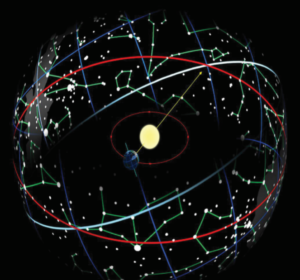
There are many small, big and very big bodies in the universe. These are known as the celestial bodies. Sun, stars, planets, asteroids, meteorites, comets, galaxies, moon – all are celestial bodies. You must have heard about polar-star, sapt- rishi mandal etc. from your elders – they also are celestial bodies which have their own light and are therefore known as the stars.
One such star is our Sun. There are many stars farther away from the Sun, hence they appear small and appear to shine to a lesser extent. Many of the stars are much larger than our Sun. The extent of the universe is beyond our imagination. It has been described, though in another form, even in our Vedas.
Indian Calender
Indian calendar (almanac) is an astronomical book based on mathematical calculations in which are mentioned the names of various celestial bodies and their movements. Millions of years ago when there were no watches or other type of time measuring devices, our ancestors determined time, date, month etc. by observing the position of these celestial bodies. The Indian almanac was prepared on this basis.
Bhartiya Almanac (Calendar)
There are five main parts of the Bhartiya calendar, hence it is known as the ‘Panchang’. They are :
- Tithi (Date) : This is similar to the date of the english months, but it is related to the lunar month. There are two phases in a lunar month which are known as the ‘Shukl paksha’ and the ‘Krishan Paksha’. There are 15 ‘tithis’ in each ‘Paksha’, two of them are the Full Moon (Poornima) and the New Moon (Amawasya).
- Vaar (days) : It is the same as the days of the week and are seven in number.
- Nakshtra (Constellations/asterisms) : The path of revolution of moon about the earth has been divided into 27 sectors. A nakshtra is a sector along the lunar ecliptic.
- Yog (Combination) : It refers to the difference at a given time in the movement of sun and moon. There are 27 Yog. It is an auspicious moment.
- Karan : Half of the part of a tithi is called a karan. Thus there are two karans in a tithi, to calculate the micro- effects of a tithi.
Apart from these the ‘panchaang’ presents many other information in a very accurate manner. Some of them have been enumerated as under :
- The daily sun-rise and sun-set time for various cities.
- Time of appearance of moon.
- Movements of sun, moon and various planets.
- Revolution of various planets in Nakshatra and Rashis i.e. in asterisms and constelations.
- Daily tithi, increase and decay in them.
- Rashi, description of the twelve months.
The Bhartiya pachang shows the daily calculations of the time and moment and the position of celestial bodies at each given moment. Of the five parts of a ‘panchang’, information regarding nakshatra and tithi is being presented in this chapter.
The current prevalent panchang is based on the Bhartiya Panchang. In it, along with the various astronomical events, the festivals and specific events of all religions have been mentioned. It is available in the language of the specific community.
Nakshatra
The group of stars in the sky is known as the constellation. In it stars are observed in a recognizable pattern. They are very far from the sun and appear to be static because they do not revolve around the sun. These groups of stars have been named for identification purpose. These names are on the basis of their apparent form or are identified with some mythological figures.

The moon completes its revolution about the earth in about 27 days. The constellations present along the lunar ecliptic are known as nakshatra. The ecliptic of moon has been divided into 27 sectors and these nakshatras present there in, are named. The table below enumerates the detailed description of these 27 nakshatra.
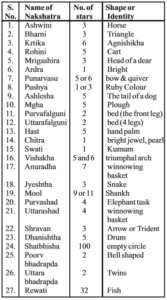
The name of the 28th nakshatra is Abhijeet which has been considered with Purvaashad.
Rashi (Signs)
Like nakshtra’s have been named on the basis of the path of moon, similarly rashi are related with earth’s movements. The earth’s orbit has been divided into twelve sectors, each sector is considered to be a rashi. According to the Bhartiya Panchang the names of these rashis and their shape are on the basis of various constellations present in the sky. The sectors of the rashi-chakra are bigger as compared those of the nakshtra-chakras. Therefore in each to there may be 2 or 3 nakshatras. Each nakshatra has been divided into four steps. Therefore there are 9 charans in a rashi.
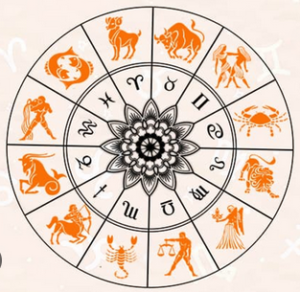
In other words we may say that since earth takes nearly one year to move around the sun, therefore the sun will remain in each rashi for about one month. The position of these rashis is known as the twelve solar months. Peruse the different shapes of the various rashis in the table given below.
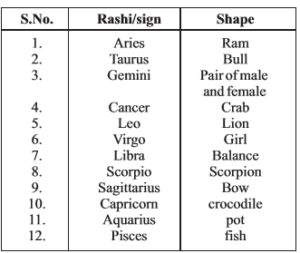
When the earth moves from one rashi to another it is known as the sakranti i.e the sun’s transition. When sun transits in Capricorn it is known as Makar sakranti. Mostly it is on 14 January.
Celestial relation of the names of the Bhartiya months
In the previous section you came to know about the twelve solar months which are related to the movement of the earth in relation to the sun. Similarly the lunar months are governed by the movement of the moon. There are 12 lunar months which have been named according to the constellations and rashis in the path of the moon’s orbit.
For example after amavasya, when the moon appears in Aries rashi and Ashwini Nakshtra and gradually increasing phase by phase becomes the full moon in Chitra Nakshtra, then this month becomes the “Chaitra” (because of Chitra Nakshtra). In other words, the month is named on the basis of the location of the moon, on Full Moon day, in a particular nakshtra. Like the full moon will be in Kritika Nakshtra during the Kartik month. The table below enlists the nakshtras with their respective months.
There is a difference in the duration of the lunar year and the solar year because of the difference in the rate of revolution of the moon and the earth. To co-ordinate between the lunar and solar months there is an increase in lunar month, every three year, which is known as the ‘adhik maas’. One month is decreased in every 150 to 200 years
Knowledge About Bhartiya Scientists
You have learnt about so many things about this universe in this chapter, have you ever thought of who provided all these informations and calculations?
This is the result of the continuous efforts of numerous astronomers, mathematicians and scientists over the years. The results and inferences of one scientists are carried by another and in this manner theforward knowledge expands. It is on the basis of the concepts and principles presented by our ancient philosophers and scientists that many of our modern equipments, gadgets, machines etc. are invented.
The contribution of Bhartiya scientists in various spheres has been immense and have astonished the world by the depth and understanding of the subject concerned. You will feel proud to study about the brief biography and the contributions made by them, that have been presented in the following section.
Aryabhatt
Aryabhatt was a great astronomer and mathematician of ancient Bharat. He was born in 476 BC. He studied at Nalanda and later on taught at this institute as he was a knowledgeable person. He brought into existence, great texts like Aryabhatiya in a very short time. It is a purely mathematical and astronomical scientific text. The direct description of Aryabhatt’s work has been known from the Aryabhatiya text only. The entire work consists of 108 verses and 13 extra in the form of introduction. It has been divided into four chapters :
- Geetikpaad (13 verses) describes the bigger units of time like – Kalp, Manvantar, Yug etc.
- Ganitpaad (33 verses) is a compilation of geometric progression and simple, quadratic, simultaneous and indeterminate equations.
- In Kaal Kriyapaad (25 verses) these are the different units of time and the method of determining the position of planets at a particular day. It also includes the calculation of “adhika mass” (i.e. the extra lunar month) and “Kshya mass’ (i.e. the decay month or the decrease in lunar month) and the names of the various days of a week.
- Golapada (50 verses) includes the geometric and trignometric aspects, orbits, shape of the earth, reasons of day and night etc.
Aryabhata had initiated the discoveries a thousand years ago for which Copernicus became famous (1473-1543 AD). The main discoveries by Aryabhata include :
- Represented the value of pie accurately.
- Earth rotates on its own axis.
- Relation between the circumference and radius of a circle.
- Area of a triangle.
- Presented hypothesis regarding the geocentric model of the solar system and analyzed the reasons for the solar and lunar eclipse.
- The time taken by earth to rotate around fixed stars was calculated to be 365 days 6 hours 12 minutes 30 seconds – which by the present day calculations have an error of just 3 minutes 20 seconds.
- Calculated the perimeter of the earth which was just 0.2% less than the actual value.
- Aryabhata was the first person who created the sine tables from 0 to 90º.
The methods of astronomical calculations presented by him were very spectacular which remained useful as the micro-calendar in Europe for centuries. The calculation of dates done by Aryabhata and his followers have been of practical importance in Bharat.
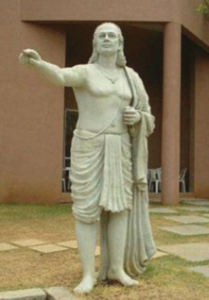
The various discoveries made by Aryabhata without the availability of advanced means are of great significance. To commemorate his work, the first Bhartiya satellite was named as “Aryabhata”.
He was a revolutionary thinker. He presented his correct opinion, although against the prevailing traditions, and paved the path of healthy traditions of scientific research in Bharat.
Varahmihir
Varahmihir was a Bhartiya mathematician th thand astronomer of the 5 -6 century. He was born in a Brahmin family at Ujjain in 499 AD. He learnt the traditional mathematics and astronomy from his father Adityadas and carried extensive research in the field. He invented the time measuring device. The iron-pillar at Indraprastha was constructed by him and established the observatory at Jundishahpur on the invitation of the emperor of Iran. All these present a glimpse of his contributions. The center of advanced mathematical science developed by him at Patthak (Ujjain) remained unique for seven hundred years.
On his visit to Kusumpur (Patna) Varahmihir met the great mathematician Aryabhatta. Young Varahmihir was so much impressed by him that he made astrology as his aim of life. Chandragupt II on coming to know about his extent and depth of knowledge, included him in his nine gems. Varahmihir gave important formulae in the field of trignometry, optics and astronomy. Morever he worked on the accuracy of the sine tables prepared by Aryabhatt I. He died in 587 AD.
Panchsiddhantika summarises five earlier astronomical texts – Surya Siddhanta, Romak Sidhhanta, Paulisa Siddhanta, Vasishtha Siddhanta and Paitama Siddhanta. Varahmihir was the first person in the history who said that there exists a force which attracts things to the earth. Today that force is known as the gravitational force.
Varahmihir’s main aim was to connect mathematics and science to public interest. In fact, this has been the tradition in Bharat from Vedic times. Varahmihir totally followed it.
Bhaskaracharya or Bhaskar II
Bhaskar II, who is also known as Bhaskaracharya was born in 1114 AD at Bijapur, Karnataka. He was the famous mathematician and astronomer of twelfth century in Bharat. He wrote the first text with full and systematic use of the decimal number system. Bhaskaracharya wrote simple commentaries on the work of Aryabhata for the common man to understand. He also wrote his own texts based on these works. He wrote a book Siddhant Shiromani in Sanskrit at the age of 36 years. It has four parts – Lilawati, Bijaganitadhyay, Grahganitadhyay and Goladhyay which are the detailed descriptions of arithmatic, algebra, Planetary mathematics and sphere. He was the chief of the Ujjain’s Astronomical observatories. Much before Newon, Bhaskaracharya had mentioned, in one of his texts that the earth pulls celestial bodies towards itself by virtue of a special force. ‘Karan Kautuhal’ is another composition by Bhaskar II, in which he has done various astronomical calculations. It is referred to while preparing the almanac (panchang). In another text, Suryasiddanta, Bhaskaracharya had made it clear that earth is round and moves around the Sun continuously in a defined orbit.
Bhaskara II also completed the incomplete works of the famous mathematician Bhramgupta (598-665 AD) whom he considered to be his Guru. Bhaskaracharya was the first mathematician who stated that the answer of any number divided by zero, is infinity. During the era when Bhaskaracharya was born and remained active in the field of science, was the time when many superstitions prevailed in our society. At such a time a rumour was spread by staunch and traditional superstitious people that earth was baseless and was sinking. They did it by misinterpreting the Puranic texts for selfish ends to keep their control over the society on the whole. At such a time, Bhaskar II, the great astronomer, fulfilled his duty as a scientist, by stating that although Earth is baseless but various planets & nakshtras present around it kept it in a balanced position by exerting gravitational force on it. The earth will remain as such and will never sink.
These facts are all the more important because the Bhartiya astronomers declared these facts years before the western astronomers and scientists did, which is a substantial proof of Bharat being the forerunner in the field of science.
Bhaskara’s astronomical views have been translated in various languages, over the years. Thus the important Bhartiya information regarding mathematics and astronomy were accepted on a global level. The great scholar Faizi, of Samrat Akbar’s court, translated Bhaskaracharya’s work ‘Lilawati’ in Persian. This text was translated into English by an english scholar Colebrooke in 1710. As a tribute to the works of this great astronomer – mathematician, the Government of India named its second artificial satellite ‘Bhaskara’.
The term II is connected to his name to distinguish him from Bhaskara I who was born in approx 6th century. He also, was a famous mathematician.
Jantar-Mantar
Other Bhartiya mathematicians who have done commendable work includes Brahmguta (628 AD), Jain mathematician Mahaveeracharya (80 AD), Shri Bhaskaracharya (991 AD) Ramanujan (1887) Subhramanyan Chandrashekhar (1936). Sawai Jai Singh II (1686-1743 AD) of the Jaipur Royal family who built observatories at Jaipur, Delhi, Mathura, Varanasi and Ujjain. These are known as the Jantar-Mantar.
Recent Post
- Yoga Sutras of Patanjali : Chapter 4: Liberation (Kaivalya Pada)
- Realme Narzo 50 5G : Buy at lowest price @ 12,999/-
- Yoga Sutras of Patanjali : Chapter 3 : Progressing (Vibhuti Pada)
- Yoga Sutras of Patanjali : Chapter 2: Practices (Sadhana Pada)
- LAVA Braze 5G : Cheapest mobile take it home. Don’t miss it
- Yoga Sutras of Patanjali : Chapter-1 : Concentration (Samadhi Pada)
- Ashtang Yog : Do you know it’s 17 Effects on Health
- Surya Namaskar : 12 Steps with pose & it’s benifits
- OPPO A98 : Full Specifications & Price in India
- Concept of Life
- Xiaomi Redmi Note 12 5G : Price, Full Specification & Launch Date
- Structure of Matter and Molecule
- Samsung Galaxy M13 5G buy at lowest price @ Rs. 9,999/-
- 7 Amazing facts about Prime Minister of the United Kingdom Mr. Rishi Sunak
- PM Kisan Tractor Yojana 2022: This Diwali, bring a free tractor at Home
- Social Media : Chapter-1, A complete free course
- Education: New Definition & Meaning and 05 Concepts
Our Partners

